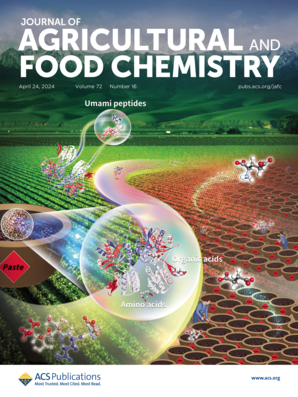Bicycled Hairpin Assembly-Mediated SERS/Colorimetric Dual-Mode Sensor for the Detection of Dexamethasone in Milk and Pork
IF 5.7
1区 农林科学
Q1 AGRICULTURE, MULTIDISCIPLINARY
引用次数: 0
Abstract
The presence of dexamethasone (DEX) residues and the illegal addition of DEX to food have garnered widespread public concern over recent decades. Based on the bicycled hairpin assembly (BHA) mechanism and the catalytic oxidase effect of urchin-shaped Au–Ag alloy loaded with Pt nanoparticles (Au@Ag@Pt), an accurate and ultrasensitive surface-enhanced Raman scattering (SERS)/colorimetric dual-mode method for DEX detection is pioneered. When DEX is introduced into the sensor system, the BHA cycle begins. The Fe3O4 nanosphere loaded with Au nanoparticles (Fe3O4@Au) surface facilitates the anchoring of a large amount of Au@Ag@Pt, resulting in synergistic signal amplification and facile magnetic separation from the complex system. Finally, the collected product effectively catalyzes the conversion of 3,3′,5,5′-tetramethylbenzidine (TMB) to the oxidized product, producing a strong SERS response, an ultraviolet–visible absorption signal, and color deepening. Our dual-mode platform achieves ultrasensitive detection of DEX, achieving a detection limit (LOD) of 6.61 × 10–17 M within the broad range of 10–16 to 10–9 M for SERS and a LOD of 8.81 × 10–13 and 6.98 × 10–13 M within the range of 10–12–10–5 M for the colorimetric method. Additionally, this platform shows high selectivity and satisfactory recovery rates for DEX in milk and pork samples, with recoveries of 92.3%–106.5% (RSDs <8.35%) for SERS and 95.2%–107.6% (RSDs <8.81%) for colorimetric analysis. This study demonstrates that by combining the BHA amplification process with multifunctional Au@Ag@Pt and Fe3O4@Au substrates, the DEX content in actual food samples can be accurately determined using a dual-mode approach that combines the high sensitivity of SERS with the simplicity of colorimetric analysis.

自行车发夹组装介导的SERS/比色双模传感器检测牛奶和猪肉中地塞米松
近几十年来,地塞米松残留和食品中非法添加地塞米松已经引起了公众的广泛关注。基于双发夹组装(BHA)机制和装载Pt纳米粒子(Au@Ag@Pt)的海胆形Au-Ag合金的催化氧化酶效应,提出了一种精确、超灵敏的表面增强拉曼散射(SERS)/比色双模DEX检测方法。当DEX进入传感器系统后,BHA循环就开始了。负载Au纳米粒子(Fe3O4@Au)表面的Fe3O4纳米球有助于锚定大量的Au@Ag@Pt,从而产生协同信号放大和易于从复杂体系中进行磁分离。最后,收集的产物有效催化3,3 ',5,5 ' -四甲基联苯胺(TMB)转化为氧化产物,产生强烈的SERS响应,紫外-可见吸收信号,颜色加深。我们的双模平台实现了DEX的超灵敏检测,SERS在10-16 ~ 10-9 M宽范围内的检测限(LOD)为6.61 × 10-17 M,比色法在10-12-10-5 M范围内的检测限(LOD)为8.81 × 10-13和6.98 × 10-13 M。此外,该平台对牛奶和猪肉样品中的DEX具有较高的选择性和满意的回收率,SERS和比色分析的回收率分别为92.3% ~ 106.5% (rsd <8.35%)和95.2% ~ 107.6% (rsd <8.81%)。本研究表明,通过将BHA扩增工艺与多功能Au@Ag@Pt和Fe3O4@Au底物相结合,可以利用SERS的高灵敏度和比色分析的简单性,准确测定实际食品样品中的DEX含量。
本文章由计算机程序翻译,如有差异,请以英文原文为准。
求助全文
约1分钟内获得全文
求助全文
来源期刊
CiteScore
9.90
自引率
8.20%
发文量
1375
审稿时长
2.3 months
期刊介绍:
The Journal of Agricultural and Food Chemistry publishes high-quality, cutting edge original research representing complete studies and research advances dealing with the chemistry and biochemistry of agriculture and food. The Journal also encourages papers with chemistry and/or biochemistry as a major component combined with biological/sensory/nutritional/toxicological evaluation related to agriculture and/or food.

 求助内容:
求助内容: 应助结果提醒方式:
应助结果提醒方式:


